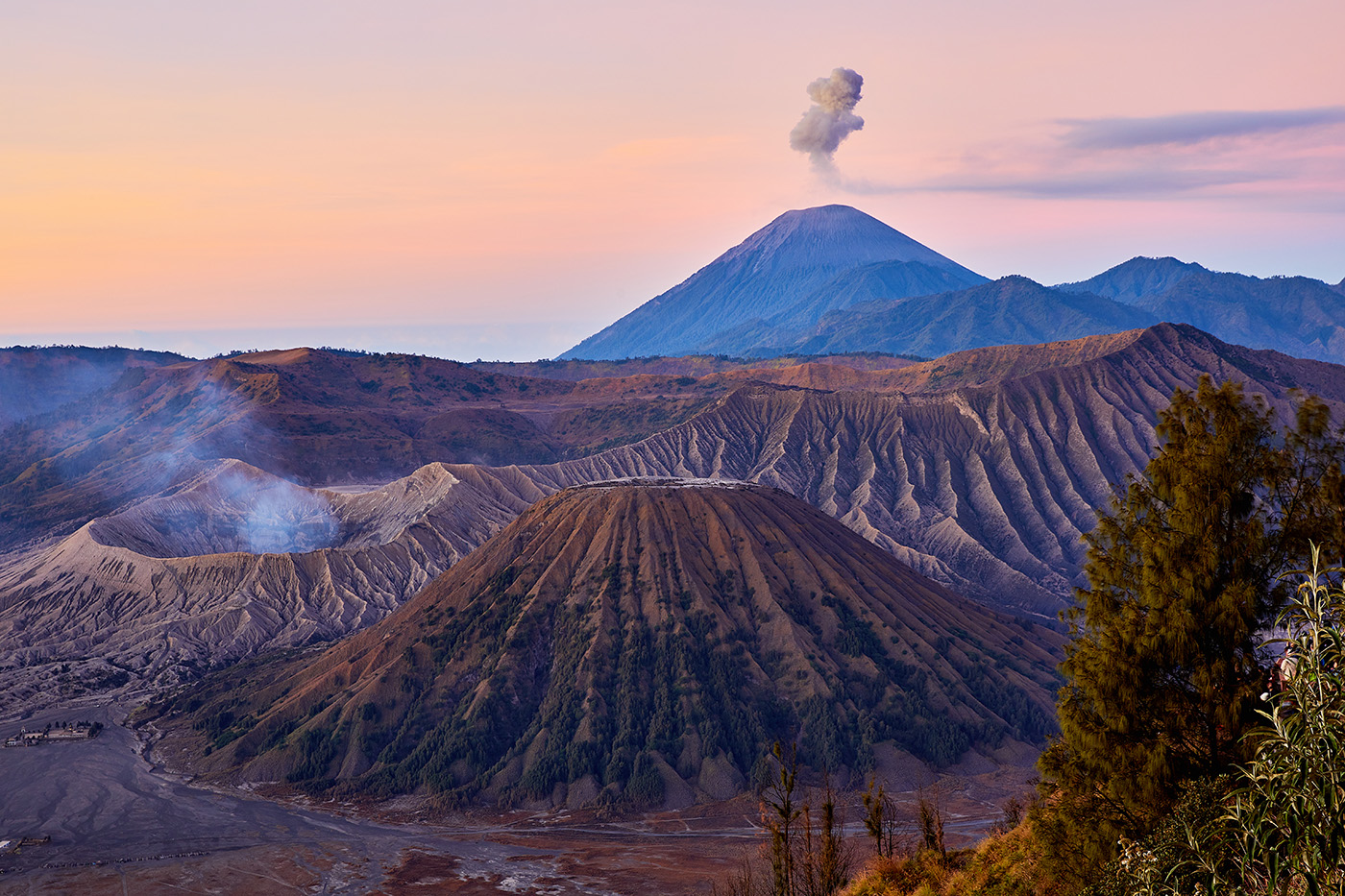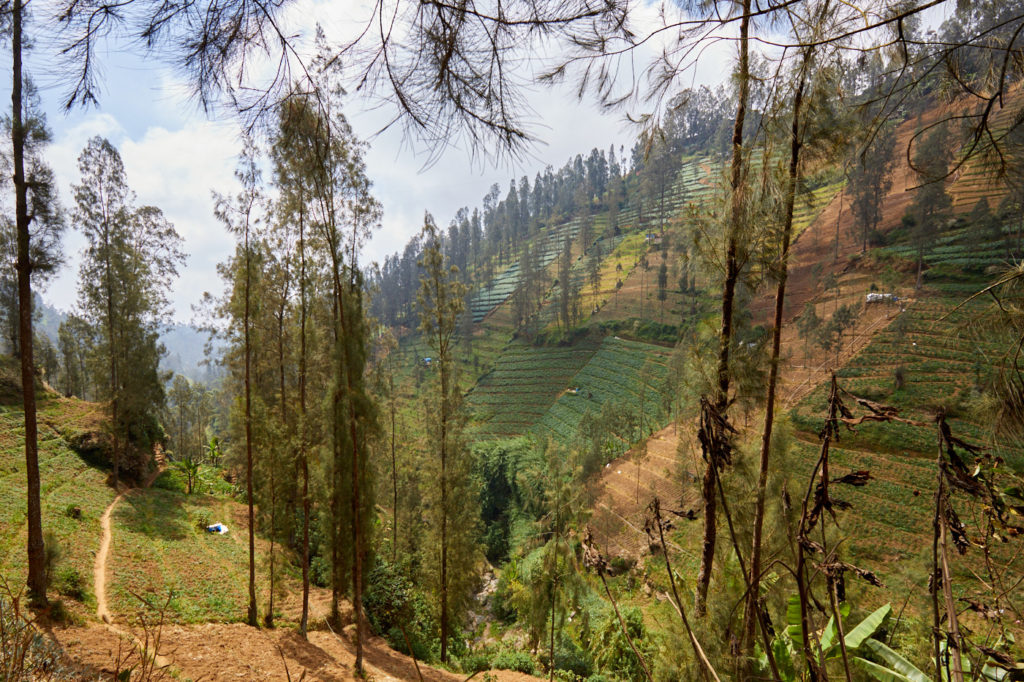Sunrise over Gunung Bromo and the Tengger Highlands

Sunrise over Gunung Bromo is one of the earth’s great spectacles. I first saw it, in less-than-perfect weather conditions, over twenty years ago. Back then there were few places to stay. The best was a small guest house at Cemoro Lawang. There were around 15-20 of us. From the guest house, it was a short walk across the sea of sand to the crater but I had my heart set on a viewpoint some way above at a place that I now know is called Gunung Penanjakan. The views from this spot were already well known but it involved a chilly, two-hour hike up a mountain in pitch dark so most people took the former option.
There were only about six of us that went to Penanjakan and dawn, even though there was not much sun, was still impressive. The ribbed cone of Gunung Batok was poking up through a sea of cloud. Bromo itself was enthusiastically belching out sulfurous gas. In the distance, Gunung Semeru was sending a column of steam to blend with the high cloud that had diffused our sunrise. We were standing on a muddy path shivering and drinking hot coffee from a flask. “There are plans to build a jeep track up to here,” our guide told us. We collectively agreed that the jeep track was a bad idea.
Nevertheless, the track was built and our fears realised by the shovel load.
The area was declared the Bromo Tengger Semeru National Park in 1982 although the Tengger Sand Sea has been a protected area since 1919. It covers an area of 5,250 hectares and is actually the caldera of an ancient volcano called Tengger through which Bromo and four other vents, Gunungs Batok, Kursi, Watangan and Widodaren, emerged. These are surrounded by the sand sea and, looking to the South, there is the impressive cone of Gunung Semeru. This is Java’s highest peak standing at 3,676 metres above sea level. It is named after the mythical Mt Meru, the centre of the world according to Buddhist and Hindu Cosmology.

I’d long harboured the idea of coming back to spend a little more time in the highlands so after a month travelling across Java I decided it would be a perfect way to round off the trip.
The last time I’d been impressed with the high mountain ridges and the tiny villages perched precariously along the top while narrow strips of agriculture tumbled down the sides. Thanks to the popularity of Bromo as a tourist destination each of these villages now has a homestay or two. The area around Tosari, about 12 kilometres to the northwest of Bromo, is particularly blessed though most visitors only stay a single night.

The highlands are best enjoyed in the mornings. The air is cool and fresh and the view, when the sun lifts itself above the trees, goes on forever. Slender ridges sloping down towards the markets of Surabaya while the massif of Gunung Arjuna looms in the distance. In the valleys, narrow terraced fields replete with carrots, potatoes, onions, cabbages and more are secured from the more inclement weather by regiments of Scots Pine whose roots keep the rich, volcanic soils from washing down the hillsides during the rainy seasons.
“We can grow almost any vegetables here but we can’t grow fruit,” said my host. “Well, it’s technically possible to grow fruit but it tastes bad because of the soil. It gives a bitter flavour.” He’d insisted we start out for Bromo at about 3 am. The caldera is only 40 minutes away by jeep and the sun wasn’t due to rise until about 5.30. “We have to go early or we won’t be able to park.” His point was amply illustrated when we reached the turn-off to Penanjakan and met a convoy of jeeps snaking up from the other direction.

Long before we reached the start of what used to be the muddy path jeeps lined the narrow road on both sides and I had to get out and walk the last 300 metres. Beyond the jeeps stalls selling hot drinks and snacks, wooly hats, scarves and gloves, souvenirs or just the opportunity to sit by the warmth of a clay pot stove. People mill about in the gloom with smartphone torches giving the scene a surreal bazaar-like quality. Most people though are heading for the path, surfaced these days though still with a layer of volcanic dust, to stake out their vantage point.
There are still around ninety minutes to sunrise. It is pitch dark across the caldera save for a few pinprick lights of visitors to the crater and the vague outline of Semeru against the sky in the distance. Above, a vast dome of stars, galaxies and distant worlds are keeping photographers amused until such time as our closest star makes an appearance.

The first evidence of this is the emergence of Batok from the shadows in the foreground then the jagged rim of Bromo itself. Before long a shaft of orange light seeps in from the left first giving definition to the summit of Semeru. Then slowly, the cones and ridges within the caldera below become more distinct until the sunshine finally floods in revealing the greens of the vegetation, the grey and ochre of the ash and earth and the last tints of orange in the sky as they fade into blue. On queue, Gunung Semeru sends up a plume of smoke.
It’s easy to forget which planet you are on. It is easy to forget you are sharing the experience with hundreds of other tourists, albeit briefly. But they will heading off to Bali, Surabaya or Yogyakarta. I shall head back to Tosari. For the rest of the day, I shall have the highlands all to myself.